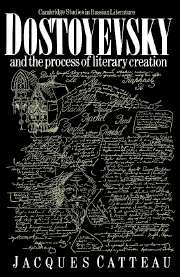Book contents
- Frontmatter
- Contents
- Preface to the English edition
- List of abbreviations
- General editor's note on transliteration and references
- General introduction
- PART I The creative environment
- PART II The process of creation
- Introduction
- 7 The writer at work
- 8 The great dialogue: the news item
- 9 The great dialogue: migrant images
- 10 The play of dialogue
- 11 The unity of thought in the novel
- 12 The summit of creative interrogation: ‘The Life of a Great Sinner’
- 13 A Raw Youth: reasons for choice
- 14 A Raw Youth: the appearance of the vision
- 15 A Raw Youth: the human architecture
- 16 A Raw Youth: the Idea of the novel
- 17 The composition of the novel in Dostoyevsky's work: choice of chronicle form
- 18 Composition of the novel in A Raw Youth: chronicle and stories
- Part III Time and space in the world of the novels
- Conclusion
- Notes
- Select bibliography
- Index of names
15 - A Raw Youth: the human architecture
Published online by Cambridge University Press: 18 December 2009
- Frontmatter
- Contents
- Preface to the English edition
- List of abbreviations
- General editor's note on transliteration and references
- General introduction
- PART I The creative environment
- PART II The process of creation
- Introduction
- 7 The writer at work
- 8 The great dialogue: the news item
- 9 The great dialogue: migrant images
- 10 The play of dialogue
- 11 The unity of thought in the novel
- 12 The summit of creative interrogation: ‘The Life of a Great Sinner’
- 13 A Raw Youth: reasons for choice
- 14 A Raw Youth: the appearance of the vision
- 15 A Raw Youth: the human architecture
- 16 A Raw Youth: the Idea of the novel
- 17 The composition of the novel in Dostoyevsky's work: choice of chronicle form
- 18 Composition of the novel in A Raw Youth: chronicle and stories
- Part III Time and space in the world of the novels
- Conclusion
- Notes
- Select bibliography
- Index of names
Summary
The formal relations in a work and between works constitute an order, a metaphor of the universe.
Henri Focillon, Vie des formesThe architectural space which we are considering is simply the way in which the chaotic whole which has just appeared is organised, or, in material terms, the complex construction of relationships between the various characters. This is originally a random movement of particles, which is gradually organised by experiment into a formal arrangement directed by the Idea.
Gravitational disposition
The human architecture in Dostoyevsky's great novels is ordered, directly or indirectly, by the underground but fundamental dream of the broad nature, which is shown at its most brilliant in ‘The Life of a Great Sinner’, where Dostoyevsky was trying to rearrange the abundant growth of the universe by developing it geometrically within the immense soul of the hero with his impulses and his contradictory actions. At the extreme point, and we have caught a glimpse of this in the plan mentioned only in the letters, Dostoyevsky would have tried to include a large slice of the history of Russia, all the great eternal questions of God and humanity, and many burning contemporary problems, or in other words a history of thought, within the sum of this monstrous creature's experiences. His first impulse was to concentrate the world, the totality which had just appeared, in the one living cell of the broad nature. This enthusiastic plan was immediately doomed to failure, or at least so it seemed.
First, the novel about the broad nature could not take place in a desert peopled with abstract phantoms.
- Type
- Chapter
- Information
- Dostoyevsky and the Process of Literary Creation , pp. 272 - 284Publisher: Cambridge University PressPrint publication year: 1989



